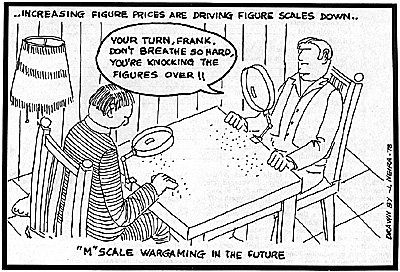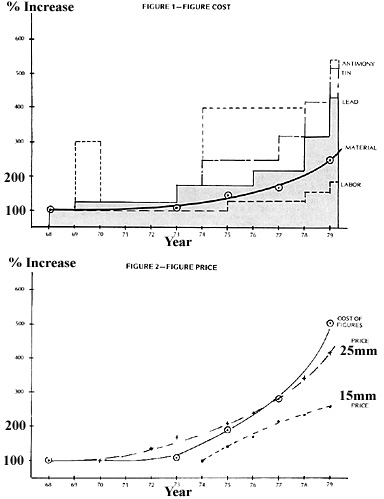The most obvious change in Miniature Wargaming over the last 10 years has been the rampant increase in figure prices.
Accompanied by a crescendo of screams and a melody of the gnashing of teeth by miniaturists, the average price of figures has increased 333% since 1968! The general feeling in the hobby is that miniature companies are making a bundle at our expense.

I felt that I could provide a much-needed service to the readership by exposing these scoundrels for the gougers they really were. How wrong I was can best be judged by studying the facts presented in this article.
Costs Considered
With the able research assistance of Tom Desmond I determined the last 10 years of change in the prices of materials that go into manufacturing a figure; namely lead, tin, and antimony. Labor cost increases were also considered.
The exact mix of metals used is the closely guarded secret of manufacturers, each considering that he has the optimum mix. Additionally, the casting difficulty size and detail of each figure will often dictate a slightly different mix of metals -- e.g. Elephants using a larger percentage of lead to keep the cost down and highly animated figures using more tin to get good detail.
I was able to deduce average percentages close to 20% Tin, 75% Lead and 5% Antimony. Allocation of the effect of labor cost increases is a more difficult problem. The labor expended per 25mm figure is obviously different from that expended per 15mm figure. But, not-so-obvious, is the fact that the different amount of handling required by 15's and 25's tend to level out the effects.
In any case, surveys of the various manufacturers suggest a labor cost to material cost ratio of 3 to 1. Thus, a FIGURE OF MERIT (FM), can be derived from which we can determine the effect of the cost of the diverse elements that go into manufacturing a miniature figure. Thus:
-
FM = 144 [ .2 X Tin cost + .75 X Lead cost + .05 X Antimony cost +3 X Labor cost] I divide by 4 to normalize to a base line of 100%.
Another factor not normally considered is the effect of overhead increases (K in the formula above), as the quality of figures has increased over the years. The items that go into overhead cost are listed below. The list is by no means complete.
Element Estimated Increase
-
a. Design Cost 82%
b. Development Cost 82%
c. Royalty Cost 50%
d. The cost of spin casting, hand-rubber mold machines vs. hand made RTV "battery molds" 100%
e. The cost of additional insurance and safety requirements of OSHA. 25%
f. Corporate taxes 100%
g. Mailing and packaging costs 300%
h. Cost of distribution in hobby shops vs. 100% sight-unseen mailorder. 160%
i. Cost of supporting conventions 100%
j. Cost of stocking 100's of figures types in many periods vs. stocking dozens in a few periods or making-to-order. 50%
k. Facility and equipment rental costs 75%
l. Heat and utility costs. 100%
It can be shown that the effect of the increase in the overhead elements results in an overall overhead rate increase of 100% (2:1). Another approach is to consider that the dollar you spent in 1968 is worth 47 cents today!
Design and Development costs, being mostly labor, tend to increase at the same rate as the minimum wage for reasons stated previously. Royalty costs, for obvious reasons, increase in proportion to the inflation rate and U.S. British money exchange rate. Spin casting machines (required for highly detailed figures), cost over earlier hand methods is an almost infinite increase e.g. spin casting machine of $10,000 and molds cost (including labor) of $60 with a life of between 100 and 400 uses depending on figure detail, vs. hand mold costs of approximately $200/year.
However, the long life of the spin casting machine and the many figures cast with it, means a very small increase in cost per figure. It is the mold cost that adds the bite. This is considered as a constant 100% after 1973. OSHA and Insurance costs are especially binding on the metal figures industry, as they use hazardous material (lead). This increase is considered to have appeared after the OSHA act and increases at the inflation rate after that.
Mailing & packaging costs have gone up in several large steps over the last 10 years, but I considered it a linear increase for simplicity. Distribution costs are due to the fact that the distributor and store each want some profit, about 50% of the figure price goes to them -- this is an increase of 100% in the cost of the figure.
Distributors
Without distributors, manufacturers would be able to stock only 3 to 7% of the presently available stock of figures and the hobbyist would have to wait many weeks to get his figures which have been ordered sight unseen! Stocking costs, which is a function of the cost of floor space, material handling equipment and personnel, have increased with the increased numbers of troops stocked.
Conventions -- everyone complains if their favorite manufacturer is not at their convention regardless of how small the convention is. The manufacturer has to pay transportation, room, board, and often, salaries for his help at the conventions, not to mention the $100+ PER TABLE space rental costs. Most figure manufacturers feel that they have accomplished something if they sell enough to break even at a convention. Other costs -- cooperate taxes, facility, equipment rental, heat and utility costs increase at about the inflation rate.
Figure 1 shows the cost increase in the subject metals & labor over the last 11 years, 1968 cost being used as the baseline or 100%. Superimposed is a plot of the FIGURE OF MERIT not including overhead. Thus, it shows the effect of the change in the elements on the overall material and labor costs.
Figure 2 shows the FM, now including overhead rate effects compared to figure prices.

Holding the Line
I, frankly, was surprised to discover -- and a quick perusal of figure 2 should convince you -- that the figure manufacturers have more than held the line over the years. They have been able to do this only by vast improvement in manufacturing method, cutting their labor cost per figure over that indicated by figure 1, by increased volume (there are more of us), and improved distribution.
Miniature manufacturers, rather than gouging their customers have, like all good businessmen hoping to make a profit, expended time, money and effort in the improvement of the efficiency of their operation and have passed much of the savings on to the customer.
Of course, we should be vigilant. Support the manufacturer who gives you the best quality and service for your dollar, while avoiding the bootlegger, copier and purveyor of shoddy merchandise. By making a reasonable profit, the manufacturer can stay in business, supplying the hobby's needs, as well as undertaking the research and experimentation in new metals and techniques that are essential to keeping figure prices down in the future. That will be the subject of a future article.
Sources
1. Data from the Commodity Research Bureau Inc.,
NY.
2. Data from the Statistical Abstract of the
US -- 1977.
Back to Table of Contents -- Courier Vol. 1 #2
To Courier List of Issues
To MagWeb Master Magazine List
© Copyright 1979 by The Courier Publishing Company.
This article appears in MagWeb (Magazine Web) on the Internet World Wide Web.
Other military history articles and gaming articles are available at http://www.magweb.com